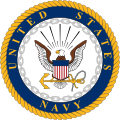Design
The design for the class had a displacement of 270 tonnes. The ships had a length of 136 feet (41 m), a beam of 24 ft 6 in (7.47 m), and a draft of 8 ft (2.4 m). The vessels were capable of 15 knots (28 km/h; 17 mph), being powered by two 440 shp (330 kW) General Motors (Cleveland) 8-268A, 2-cycle diesel engines which drove two shafts.
The ships had a complement of 32. Their armament comprised one single 3-inch/50 caliber gun mount, two 20 mm anti-aircraft guns and two depth charge projectors.
YMS-1-class ships were relatively small compared to larger contemporary US Navy ships. This led to a view by some sailors that the YMS-designated ships were cramped and particularly unsteady. These conditions were described (and surely exaggerated) by one author in a humorous poem "warning" other sailors to not transfer:
Men don't live on YMS's
they just exist under strains and stresses,
tossed around like a bundle of peas,
inside their ship on the calmest seas.
—
Anonymous, "A Plug for a Distinguished Nervuos Cross" [1]
Subclasses
There were two mostly cosmetic sub-types of the class, sometimes referred to as classes themselves
YMS-135 subclass
This subclass was identical but had only one stack rather than two, and consisted of hull numbers YMS-135 through -445, YMS-480, and YMS-481.
YMS-446 subclass
This subclass was also identical but had no stacks, and comprised YMS 446–YMS 479.
BYMS
Eighty vessels of the class were ordered from US yards for transfer under Lend-Lease to the United Kingdom as the BYMS-class minesweeper. Another 53 built for the US Navy (with hull numbers between YMS-137 and -284) were transferred as further BYMS and another 17 were delivered later.
Other exports
France received 31 YMS-class minesweepers during World War 2, with one (D202, formerly YMS-77) being sunk by a mine in 1944. France kept its YMS-class ships in service after the end of the war, [4] with seven remaining in service in 1962, used as training ships in the École Navale and as experimental vessels. Three ships of the class were transferred from France to South Vietnam in 1954, while another was transferred to Madagascar in 1961. [5]
In 1947, Poland acquired former BYMS-2211 (renamed ORP Delfin), BYMS-2257 (renamed ORP Foka), and BYMS-2282 (renamed ORP Mors). [6] The vessels were re-armed with Soviet 85 mm air defense gun M1939 (52-K) and four Soviet NSV machine guns. In the mid-1950s, they were removed from service. The ORP Delfin was scuttled in the Bay of Puck, where it remains a diving attraction.
The Japan Maritime Self-Defense Force received 8 vessels of this class in the 1950s. The class was named Ujishima-class minesweeper. The ships were:
This page is based on this
Wikipedia article Text is available under the
CC BY-SA 4.0 license; additional terms may apply.
Images, videos and audio are available under their respective licenses.

